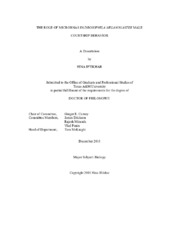| dc.description.abstract | Drosophila melanogaster courtship, although stereotypical, continually changes based
on cues received from the courtship subject. Such adaptive responses are mediated via
rapid and widespread transcriptomic reprogramming, a characteristic now widely
attributed to microRNAs (miRNAs) along with other players. Here, we conducted a
large-scale miRNA knockout screen to identify miRNAs that affect various parameters
of male courtship behavior. Apart from identifying miRNAs that impact male-female
courtship, we observed that miR-957 mutants performed significantly increased malemale
courtship and chaining behavior whereby groups of males court one another. We
tested the effect of miR-957 reduction in specific neuronal cell clusters, identifying miR-
957 activity in Doublesex (DSX)-expressing and mushroom body clusters as an
important regulator of male-male courtship interactions. We further characterized the
behavior of miR-957 mutants and found that these males court male subjects rigorously
but do not elicit courtship. Moreover, they fail to lower courtship efforts towards females
with higher levels of anti-aphrodisiac pheromones. At the level of individual
pheromones, miR-957 KO males show a reduced inhibitory response to both 7-Tricosene
(7-T) and cis-vaccenyl acetate (cVA), with the effect being more pronounced in case of
7-T. Overall our results indicate that single miRNAs can contribute to regulation of
complex behaviors, including detection of chemicals that control important survival
strategies such as chemical mate-guarding and maintenance of sex and species-specific
courtship barriers.
I also discuss the results of experiments conducted to understand whether fat body
expressed miRNAs contribute to courtship regulation and whether fat body secretes
miRNAs into circulation. These experiments were conducted in an effort to track in vivo
inter-organ exchange of miRNAs. In the last section of this dissertation I discuss the
progress made in this context and also the limitations of this approach. | en |


